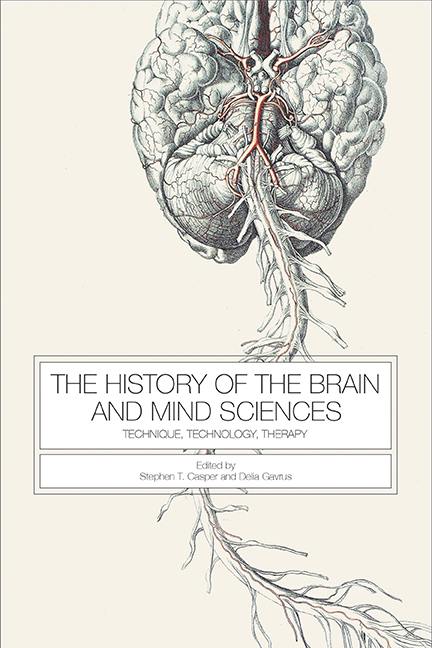Book contents
- Frontmatter
- Contents
- Acknowledgments
- Introduction
- 1 “We Are Veritable Animals”: The Nineteenth-Century Paris Menagerie as a Site for the Science of Intelligence
- 2 “Physiological Surgery”: Laboratory Science as the Epistemic Basis of Modern Surgery (and Neurosurgery)
- 3 Configuring Epidemic Encephalitis as a National and International Neurological Concern
- 4 Circuits, Algae, and Whipped Cream: The Biophysics of Nerve, ca. 1930
- 5 Epilepsy and the Laboratory Technician: Technique in Histology and Fiction
- 6 “What Was in Their Luggage?”: German Refugee Neuroscientists, Migrating Technologies, and the Emergence of Interdisciplinary Research Networks in North America, 1933 to 1963
- 7 Dualist Techniques for Materialist Imaginaries: Matter and Mind in the 1951 Festival of Britain
- 8 A “Model Schizophrenia”: Amphetamine Psychosis and the Transformation of American Psychiatry
- 9 Salvation through Reductionism: The National Institute of Mental Health and the Return to Biological Psychiatry
- Coda: Technique, Marginality, and History
- Bibliography
- List of Contributors
- Index
5 - Epilepsy and the Laboratory Technician: Technique in Histology and Fiction
Published online by Cambridge University Press: 26 May 2021
- Frontmatter
- Contents
- Acknowledgments
- Introduction
- 1 “We Are Veritable Animals”: The Nineteenth-Century Paris Menagerie as a Site for the Science of Intelligence
- 2 “Physiological Surgery”: Laboratory Science as the Epistemic Basis of Modern Surgery (and Neurosurgery)
- 3 Configuring Epidemic Encephalitis as a National and International Neurological Concern
- 4 Circuits, Algae, and Whipped Cream: The Biophysics of Nerve, ca. 1930
- 5 Epilepsy and the Laboratory Technician: Technique in Histology and Fiction
- 6 “What Was in Their Luggage?”: German Refugee Neuroscientists, Migrating Technologies, and the Emergence of Interdisciplinary Research Networks in North America, 1933 to 1963
- 7 Dualist Techniques for Materialist Imaginaries: Matter and Mind in the 1951 Festival of Britain
- 8 A “Model Schizophrenia”: Amphetamine Psychosis and the Transformation of American Psychiatry
- 9 Salvation through Reductionism: The National Institute of Mental Health and the Return to Biological Psychiatry
- Coda: Technique, Marginality, and History
- Bibliography
- List of Contributors
- Index
Summary
That's a popular misconception about science, Nett. But, Science, on the contrary, is very humanly warm and frail. It makes very human mistakes and has to change its views often so that, like the rest of humanity, it can go blundering steadily forward.
—Edward Dockrill, mid-1930sIn the interwar period, Gerry Armstrong, a technician working at a prestigious Canadian hospital, spoke passionately against the invisibility of laboratory workers. Dependent on the patronage and research funds of elite doctors and scientists, the technicians who mastered staining techniques received no formal acknowledgment for their scientific endeavors. “I’m paid to produce results,” Armstrong reflected bitterly. “Whoever pays me has the social and economic right to take what they are paying for.” This invisible labor formed the “stepping stones for somebody else's rise to fame,” Armstrong lamented, while technicians were too worried to demand public recognition for fear of losing their jobs and “falling into the gutter.” Mustering all the courage and frustration he felt, Armstrong did confront his superiors on several occasions, receiving either blank incomprehension or hollow placations.
Gerry Armstrong did not actually exist. He was a character conjured up by Edward Dockrill, a real-life laboratory technician who wrote a manuscript titled “The Means Are Nothing,” a complex, nearly four-hundred-page novel that never saw the light of print. Set mostly in the fictional bilingual town of Tasville—a lightly disguised Montreal—the novel is a bildungsroman that slowly unspools the young hero's life as he arrives to North America from England with the explicit goal of proving his worth. Armstrong is dazzled at first by the hospital and its chief, Dr. Meadowes, and he throws himself passionately into his work in the pathology laboratory. Soon, however, disillusion sets in. After many nights of exhausting labor to perfect histological techniques, he watches helplessly as one of the senior doctors appropriates one of his own breakthroughs, publishing it to great acclaim and giving Armstrong no credit, despite having promised to share the laurels of scientific discovery. The story's climax stages an explosive encounter between Armstrong and Meadowes, the technician accusing the chief and his acolytes of “becom[ing] famous with work you never did, paid for by money you never owned.”
- Type
- Chapter
- Information
- The History of the Brain and Mind SciencesTechnique, Technology, Therapy, pp. 136 - 163Publisher: Boydell & BrewerPrint publication year: 2017
- 1
- Cited by

